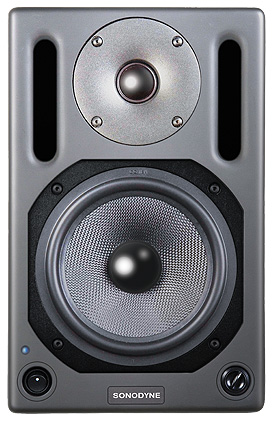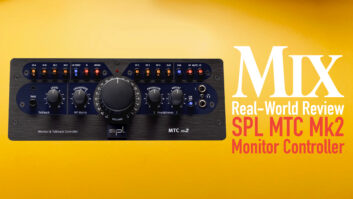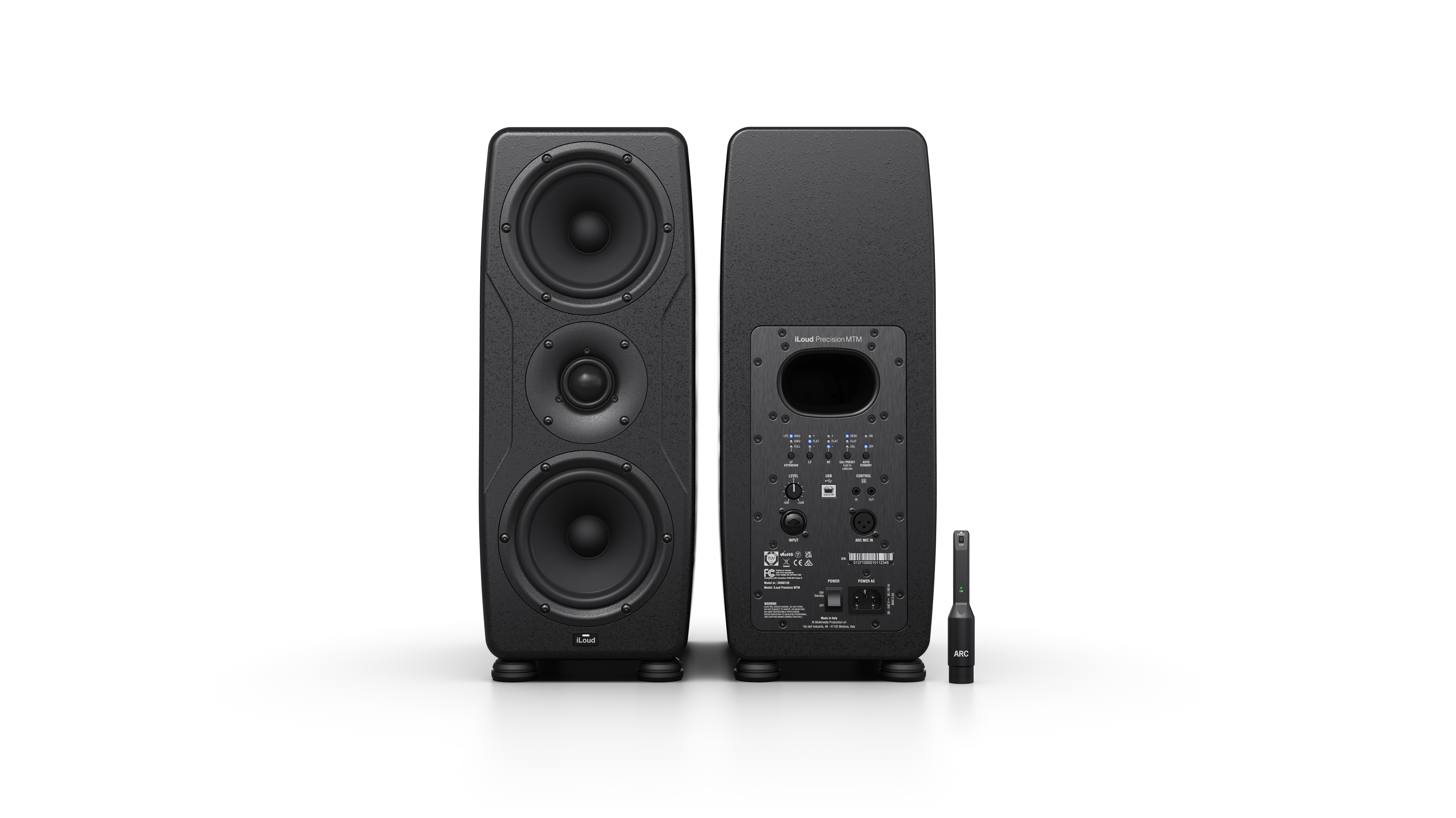
In the 1960s, engineering student Ashoke Mukherjee launched Sonodyne with the idea of bringing stereo sound to India; ever since then, he has been providing both consumer and professional audio solutions out of the company’s manufacturing facilities in Kolkata, India. I had heard rumors of Sonodyne for many years but never had the chance to hear their professional audio products. They now have distribution in the United States through the TransAudio Group out of Las Vegas, which gave me the opportunity to review their SM 100Ak Active Monitors. I found a range of pleasant surprises.

SOLID BUILD
Right out of the box, these little speakers appeared to be formidable contenders. There is a “heft,” weightiness and finish about their manufacturing that spells “well done.” The cabinets are constructed of die-cast aluminum, providing limited cabinet-induced resonance, which is a characteristic of a much more expensive line of speakers out of Finland. Also, the cabinet comprises a non-parallel design, both internally and externally, diminishing internal standing waves and providing a front-baffle time-alignment characteristic from this slightly trapezoidal cabinet. The cabinet is front-ported, with dual elongated ports placed vertically between the tweeter and edge of the speaker cabinet. The port does not output excessive air and sounds in-phase with the excursion of the woofer. All edges of the cabinet and ports are rounded to reduce edge diffraction and turbulence.
The low-frequency driver is a 6.5-inch Kevlar cone woofer in an aluminum die-cast frame, which makes for a fast, efficient, lightweight motor on the bottom end, resulting in a punchy low end that performs beyond its size. The top-end driver is a 1-inch silk dome tweeter, and even with a rather shallow waveguide, it provides a wide sweet spot when mixing. The tweeters have a smooth high-frequency reproduction characteristic. I am a big fan of the silk-domed design, having heard everything from aluminum horns to beryllium tweeters, and these sound very accurate and smooth. The frequency response of the entire system is rated at 60 Hz – 22 kHz +/- 2 dB, 50 Hz – 30 kHz @ -10dB. You will need to provide a subwoofer if you want to accurately reproduce information below 60 cycles, making these speakers perfect for a 2.1 or multichannel system.
The onboard amplifiers output 80 watts for the woofer and 40W for the tweeter. This is not a massive amount of power, but for this particular speaker size, the amps, along with the crossover, are matched to the transducers with a high degree of precision, making the system work very well within its design parameters. The crossover is a 4th-order Linkwitz Riley design splitting the signal at 1.8 kHz. The transition between subwoofer and tweeter is smooth, and for a two-way design, virtually seamless, even in a near-field monitoring position.
Operational controls include a front panel on/off switch, as well as a volume control. The back panel provides input access to the amplifiers via balanced XLR and TRS connectors. Additionally, there is a gain control, infinitely variable from -6 dB to +6 dB, and four DIP switches: a 6dB/octave roll-off at 80 Hz, a bass tilt at 80 Hz giving a -2dB or -4dB/octave roll off (very useful when mounting the speakers close to a boundary), and a high-frequency tilt, giving a shelf cut of 2 dB above 4 kHz. As you can see, there is more control over the usually offending bass frequencies, due to room anomalies, bridge placement and back-wall acoustic issues. I would like to see a midrange EQ control in a future design. Many speakers are used in “desktop configuration” and can benefit from an EQ dip/cut around 160 Hz. There is a built-in, non-user-defeatable, 40Hz, 12dB/octave subsonic filter in line to avoid over excursion of the subwoofer. That’s fine; you don’t want to blow up these great-sounding little speakers!
There are plenty of safeguards. Along with the subsonic filter, there is over-current and overheat protection, as well as RFI and on/off transient filtering. I believe Sonodyne has thought of just about everything for a product in this price range.

SONIC SUGAR
Right out of the box these speakers sounded really, really good. I usually warm up to the sound of any given transducer and take my time learning the speaker, but as soon as I fired these up, it was apparent that these were well designed. As with any speaker, they started to sound even better after a break-in period. But I didn’t have to run these for 100 hours at 100dB SPL to loosen them up. Generally, front port designs take a little longer to break in; getting the motor to work in-phase with the port takes some big air movement on the woofer to loosen it up. But these were punchy, with very little port turbulence on initial application of signal.
As far as SPL goes, these are not going to fill a large room—that’s not what they are designed to do. They work very well in a near-field situation. The big question: Is the sound transferable to other speaker systems? The answer is yes. Mixes performed on these speakers sounded extremely close to being the same mix on other, more expensive speakers.
I listened to many different source tracks, both mixed and mastered, as well as raw tracks from Pro Tools sessions at 24-bit/44.1 kHz. What I found truly revealing (and truly delightful!) was the vocal range. Vocals are represented with the utmost detail and presence. There is an intimacy, with center imaging that is wide and solid. Reverbs have a depth that seemed to image and reproduce outside the speaker box. The “in-your-face” character of electronic music reproduction matches up with my reference speakers that cost more than twice as much.
Bass guitar is well articulated with very little of the “small box” sound associated with a smaller design. Drum timbre is reproduced accurately, with cymbals having only slight coloration by comparison to my titanium references. Clean electric and acoustic guitars showed all the timbre of the original tracks. The distorted guitars of Norwegian death metal sounded only slightly forward, but there was no smear, masking or intermodulation distortion between like-timbered instrumentation. Hammond organ delivered all the nuances of a Leslie speaker system reproduced with accuracy. Even the intricate harmonics of acoustic piano where reproduced realistically on these little 6.5s. My references are rear ported, so there is a difference in the low-mid, upper-bass reproduction due to the positioning of the ports, that being a slight increase of amplitude in the 120 to 240Hz range—not a bad thing for a speaker this size, considering the system’s roll-off at 60 Hz. The result is that the speaker sounds “full,” with no hole in this critical range, which I have found missing in speakers of this size in the past.
PREMIUM PERFORMERS
The Sonodyne SM 100Ak monitors perform well beyond their price point. There are few speakers on the market right now that offer this level of accuracy and reproduction in the 6.5-inch range at this price point. Punchy on the bottom end, a smooth and accurate silk tweeter, along with solid engineering principles, make the SM 100Ak a complete package; a solid performer at a ridiculously reasonable price. Get five of these, and a subwoofer, and start mixing in surround, please! A must listen!
Bobby Frasier is an educator, audio engineer and Beatles fanatic.

Click on the Product Summary box above to view the Sonodyne SM 100Ak Monitors product page.







